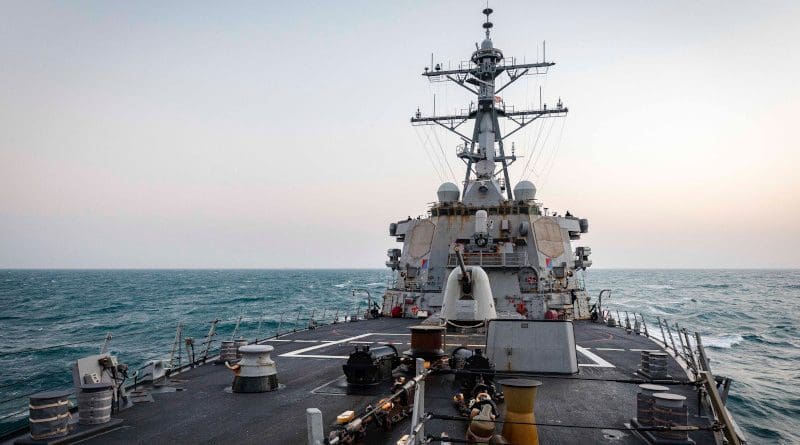Philippines Supports US Backing In Bid To Defend Manila In South China Sea
By BenarNews
By J.C. Gotinga
The Philippines welcomes an American commitment to back it should Beijing become aggressive in the South China Sea, Manila’s defense department said Thursday, after Washington warned that an armed attack on the Southeast Asian nation would force the U.S. to aid its ally under a decades-old treaty.
For weeks, the Philippine government has engaged in a verbal tussle with Beijing and lodged diplomatic protests over the presence of dozens of Chinese ships in contested waters of the sea, but China has denied the allegations and said these are fishing vessels.
“The U.S. admonition to China against the use of force on Philippine public vessels and aircraft, which are performing their constitutional mandate to protect and defend Philippine rights in the South China Sea, including the West Philippine Sea, is an additional affirmation of the long-standing partnership between our two countries,” said Arsenio Andolong, a spokesman for the Philippine Department of National Defense.
“As the situation in the West Philippine Sea evolves, we keep all our options open in managing the situation, including leveraging our partnerships with other nations such as the United States,” Andolong said, referring to the section of the South China Sea claimed by the Philippines.
A day earlier, the U.S. State Department reiterated that Washington was backing its longtime Asian ally – a former American colony – in the ongoing dispute over the Chinese ships moored at Whitsun Reef, which lies within the Philippines’ exclusive economic zone (EEZ), and other disputed waters in the Spratly Islands.
“As we have stated before, an armed attack against the Philippines armed forces, public vessels, or aircraft in the Pacific, including in the South China Sea, will trigger our obligations under the U.S.-Philippines Mutual Defense Treaty,” Ned Price, the department’s spokesman, told a daily press briefing in response to a reporter’s question.
Under the auspices of the 70-year-old treaty, the armed forces of the United States and the Philippines will come to each other’s military aid in the event of an external attack on one of them.
Despite repeated calls by Manila for the ships to leave the area and the filing of diplomatic protests, the Chinese vessels have lingered there.
Last week, the Philippine military said dozens of Chinese militia ships were scattered among contested reefs and islets in the Philippine EEZ.
China’s foreign ministry has insisted the area around Whitsun Reef belongs to Beijing.
“The Philippines attempts to use an illegal, null-and-void award to negate China’s sovereignty, rights and interests, negate Chinese fishermen’s fishing history and rights in their traditional fishing grounds,” Chinese Foreign Ministry Spokesman Zhao Lijian told reporters during a press briefing on Tuesday.
“We hope the Philippines will look at this objectively and correctly, immediately stop wanton hype … and avoid casting negative influence on bilateral relations and the overall peace and stability in the South China Sea,” he said.
The Chinese Embassy in Manila did not immediately respond on Thursday to the Philippine and U.S. statements.
Beijing insists much of the South China Sea is its territory, despite a July 2016 international arbitral ruling by a United Nations-backed tribunal that affirmed the Philippines’ EEZ.
Other governments claiming parts of the South China Sea are Brunei, Indonesia, Malaysia, Taiwan and Vietnam. Although Indonesia does not consider itself a claimant in the territorial disputes, China claims historic rights that overlap with Indonesia’s EEZ.
Ongoing protests
Since Monday the Philippine Department of Foreign Affairs has filed daily protests against China about the ships in its EEZ.
On Wednesday, Foreign Secretary Teodoro Locsin Jr. again demanded that all the Chinese ships move out.
“Nobody fishes by lashing ships together. Last time that was done was the Persian invasion of Greece recorded by Herodotus,” Locsin said in a Twitter post late Wednesday. “We’ve seen that movie.”
The Chinese presence in the Philippine EEZ also has Manila counting on its Visiting Forces Agreement with Washington, which President Rodrigo Duterte has threatened to terminate.
In February, Lloyd Austin, the defense chief in the new Biden Administration, reaffirmed Washington’s commitment to the 1999 VFA and the 1951 Mutual Defense Treaty during his first official phone call with his Philippine counterpart, Delfin Lorenzana.
The VFA, which allows the presence of U.S. troops in the Philippines, has remained in effect since Manila deferred its termination.
The pact is also the basis for another defense cooperation agreement, which allows U.S. troops to pre-position assets at certain Philippine military bases.
“We are continuously in talks with the U.S. on the matter of mutual defense,” Andolong said Thursday.
“Both parties are committed to undertake their obligations under the Mutual Defense Treaty so that neither stands alone in these issues involving the two states’ inherent right of self-defense, individually and collectively,” he said.
The U.S., meanwhile, has maintained naval patrols in the South China Sea. On Sunday, the Theodore Roosevelt Carrier Strike Group entered the waterway to carry out maritime strike exercises, anti-submarine operations, coordinated tactical training and other activities, according to the U.S. Navy.
On Wednesday, the Royal Malaysian Air Force announced it had completed a two-day bilateral military exercise in the sea with the Roosevelt strike group.

